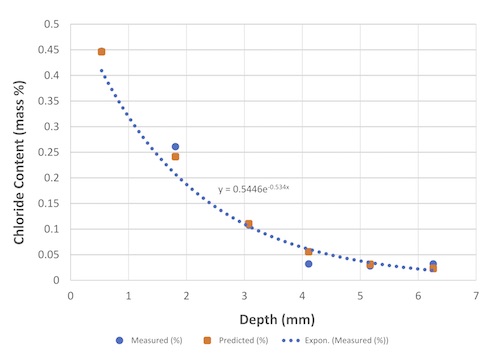
ASTM C1556 is a test we use to assess the ability of concrete to resist the ingress of chloride ions. If we’re designing a high-performance concrete for a new parking garage or bridge deck for durability in a northern climate, this is a good way to compare the relative performance of candidate mixtures. We can also use the data to predict the service life.
Assessing existing structures
The sampling method from ASTM C1556 is also useful in assessing existing structures. In some municipalities, including Minneapolis and St. Paul, local ordinances require periodic inspection by an engineer to verify the safety of parking garages.
The data from ASTM C1556 allow us to obtain a chloride concentration profile, a plot of the chloride concentration in the concrete as a function of the distance from the surface. Knowing the age of the structure, we can calculate the apparent diffusion coefficient. We can also predict how long it will take for the chlorides to reach the surface of the steel reinforcing bars.

Chloride profiles used to be rather crude measures of chloride migration into concrete. AASHTO T259, for example, requires sample thicknesses of 1/2 inch. For a concrete designed for durability to deicing salts, that doesn’t give us good enough resolution for meaningful comparisons. There simply aren’t enough data points to tell us what we need to know. But ASTM C1556 gives much better resolution.
Maintaining the value
Once we have the data and a predicted service life, we can help the owners of parking garages maintain the value of these assets. It’s a fairly common practice in our area for parking-garage owners to wash the decks periodically to remove salt from the concrete near the surface. Because chloride migration is driven by concentration, lowering the concentration of salt reduces the driving force and slows migration.
Related test methods
There are other tests we can use to assess the ability of concrete to resist penetration by water or by chloride ions. NT Build 492 and ASTM C1202 both test for chloride-ion migration, while ASTM C1876 (formerly ASTM C1760) measures the electrical resistivity. Both ASTM C1556 and NT Build 492 provide data for service-life prediction, but give somewhat different results. We can help you decide how best to specify durable concrete for your project.
